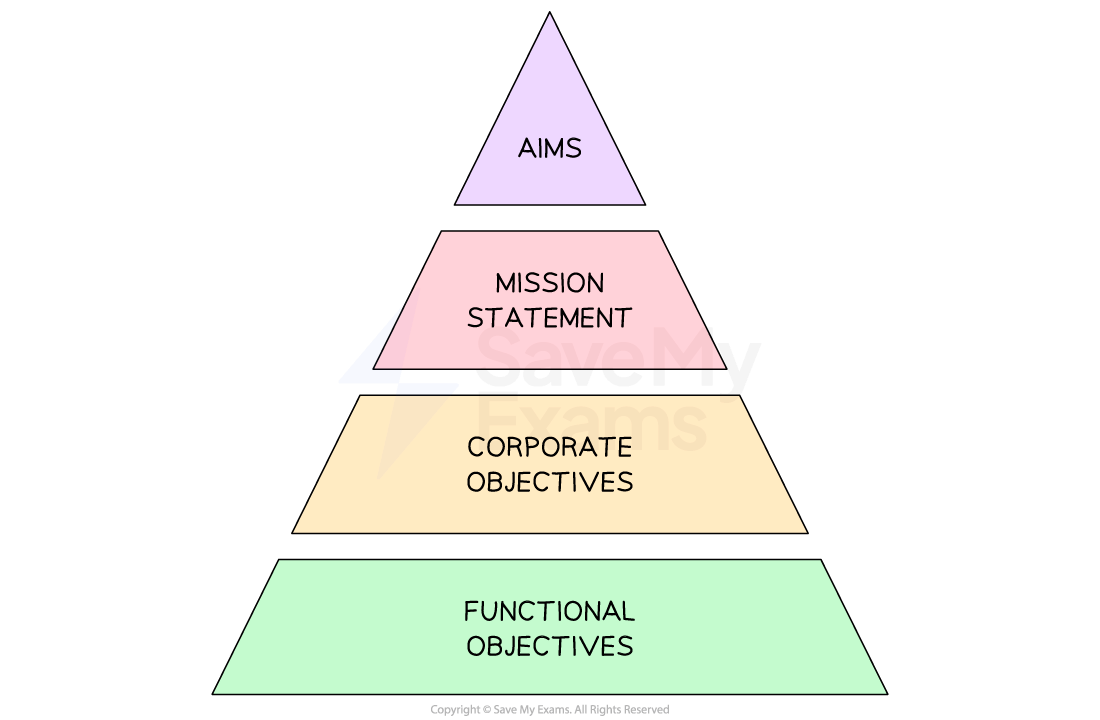Corporate Objectives (Edexcel A Level Business): Revision Note
Exam code: 9BS0
Developing corporate objectives
Aims and objectives serve as a guide for a business's overall strategy and direction, helping to focus efforts and resources towards a common purpose
There is a hierarchy of objectives that cascades downwards
The hierarchy of objectives

A business's mission flows from its overall aim and is usually expressed in inspirational terms
From this mission, corporate objectives and functional objectives that detail the achievable goals a business wants to meet over a specified period are developed
Components of the hierarchy of objectives
Component | Explanation | Example |
|---|---|---|
Aim |
| Macmillan Cancer Support: "To do whatever it takes to support people living with cancer" |
Mission statement |
| Age UK: "Making a positive difference by putting older people, and the people around them, at the heart of all we do; working with partner organisations to improve the quality of later life and provide effective, timely support for those who need it the most" |
Corporate objective |
| Mind UK: "Provide 3m employees in low-paid sectors with workplace wellbeing support" |
Functional objective |
| Scope UK: "Working with the Government and disabled people, we will create a Passenger Charter, an information resource to help disabled people find the information they need when using public transport" |
SMART objectives
Corporate and functional objectives should be:
Specific
Measurable
Agreed
Realistic
Time-bound
An example of a SMART sales objective

Critical appraisal of mission statements and corporate aims
Businesses need to critically assess whether corporate aims and mission statements continue to reflect their current corporate vision
The content and expression of business aims will likely change over time to reflect changing social attitudes and norms
For example, Apple’s new mission statement — "to make the best products on earth, and to leave the world better than we found it" — emphasises its commitment to sustainability, a key social trend
Mission statements are sometimes criticised as being little more than an exercise in public relations that does little to inform objective-setting or promote a common organisational goal
For example, in 2013, KFC’s mission was "To sell food in a fast, friendly environment that appeals to price conscious, health-minded consumers" — but in the same year, it launched a burger that replaced the bread bun with extra layers of deep-fried chicken
Businesses should decide whether changes to the corporate aim or mission statement need to be made by considering whether:
The short- to medium-term strategies adopted by the business support the aim and mission
The aim and objectives are realistic and achievable in the current trading environment
The mission statement message communicates the aim of the business effectively to stakeholders
Revising the business aim and revisiting the mission statement should be seen as a natural step for growing businesses
It is a chance to involve a variety of stakeholders, including workers and suppliers, in determining the direction of the business
Newly identified opportunities and threats can be acknowledged
Sharing refreshed priorities, particularly with the media, can generate positive publicity
Examiner Tips and Tricks
When assessing the nature or effectiveness of the objectives for a specific business based on a case study provided, you should consider the following:
What is the purpose of the objectives?
Who is the intended audience?
How does the corporate strategy followed by the business compare to the mission in reality?
Who is the mission statement aimed at, and how does the strategy affect different groups?

Unlock more, it's free!
Did this page help you?